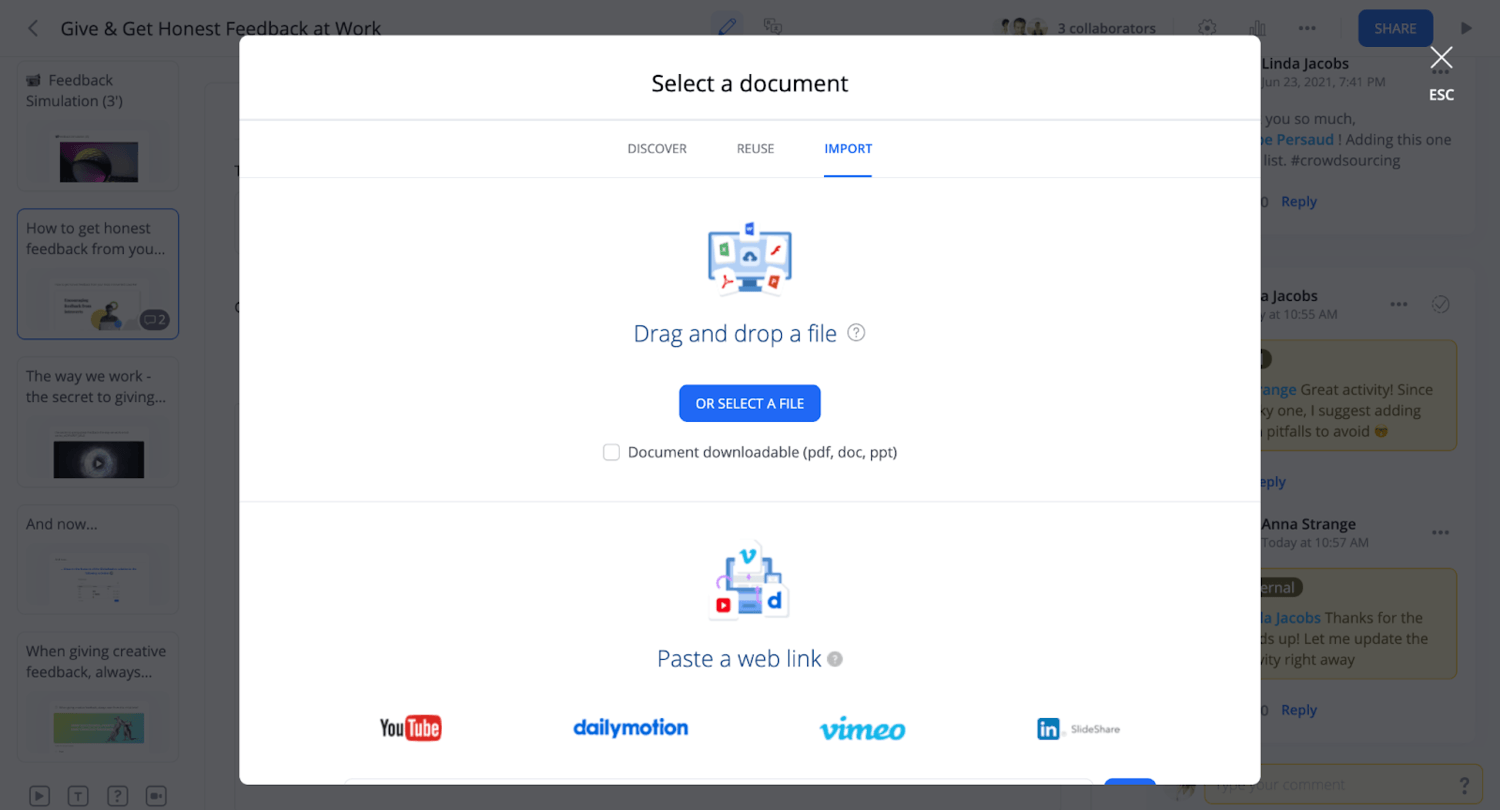Most courses aren’t collaborative. Leaders infer employees’ needs and create a undertow teaching skills to overcome them. It’s less constructive to do it this way—what would be largest is if leaders could interreact with employees to determine exactly what and how they want to learn.
360Learning allows for collaborative learning and training. Employees and leaders work together to create a relevant and helpful course. If something can be better, they can suggest how to modernize it or simply transpiration it themselves. The collaborative work ensures every undertow is high-quality, up-to-date, and relevant. For example; AirCall achieved a 99% relevancy score on classes and a 97% completion rate for employee-created courses with 360Learning’s collaborative learning platform.
Follow the next six steps to creating an turned-on training undertow on which employees can collaborate. Workers’ involvement ensures that the training is helpful and launches in the shortest value of time possible.
1. Interview employees
Talk with some employees you wish to upskill to learn well-nigh their job’s challenges. When you know their problems and have the space to discuss them in detail, you have the information you need to create valuable training.
Don’t just jump into the deep questions right away; start with some small talk so your employee feels comfortable. Discussing the most pressing issues from the start can overwhelm employees.
Ask them to describe worldwide problems they squatter and have them walk you through the word-for-word situations where they squatter these problems. With this information, you can decide if a skill would solve these issues or if the problem lies in how employees do tasks.
Drafting some of these questions earlier is okay, but don’t stick to a rigid script. You want the conversation to spritz naturally with follow-up questions to truly understand the problem and identify possible solutions. Digging into these topics can reveal worthier problems to solve than the ones you considered.
2. Create a script and a storyboard
Scripts outline the video’s structure and speaker’s lines, and storyboards depict events. Create these documents to save time stimulative redundant, confusing, or wearisome scenes.
You should review both with your team and cut what doesn’t fit or what you could explain better:
- You’re the only one who understands a section? Rewrite it.
- Added something you love, but teammates tell you it’s redundant? Reconsider it.
- Did you add too many statistics to your script? See if visualizing them with charts would make the scene clearer.
Develop a structure for your script that helps you succeed your goal. If you want to teach a specific skill, ask yourself, “What information should the speaker say to help employees master this?” Write the answer. Then move paragraphs virtually until the sequence of events is engaging and cohesive.
Your storyboard should consist of a series of boxes showing rough sketches of your scenes with the lines and direction for that scene written underneath. You can get started creating one with our self-ruling storyboarding template. Think of everything you need to exhibit in the scene to unmistakably communicate your message, then quickly yank them in the boxes. Don’t worry well-nigh making them too detailed; you just need to provide a rough idea of the scene so you can garner feedback.
3. Make your video with Vyond
For collaborative learning to work, employees must be worldly-wise to share their knowledge easily. If creating a undertow takes a long time, they won’t have time to produce it with their rented schedule. Vyond is an volatility software with dozens of templates you can use to quickly turn your storyboard and script into a helpful video.
Start by logging into your free Vyond account and clicking on “Create a new character” in the top left corner of the interface. Diamond a weft from scratch, or model it without someone in your visitor to lend validity to what they say. There are many suit and body full-length options to recreate any employee.
Now you need to make your weft move. Select them and click on the Actions menu. You will find many movements your weft can do, such as jumping, checking their watch, and pointing in one direction. Choose the one you like to get your weft moving. If you want your weft to move wideness the screen, select your weft then and unshut the Motion Paths menu. Combine Actions and Motion Paths to recreate every movement you planned in your script.
Now it’s time to record your lines. Surpassing you start, make sure you get a good night’s rest, as sleep pennilessness makes your voice sound rough. Not drinking water has the same effect, so stay hydrated throughout the day.
Once you’ve prepared your voice, wangle the Mic Recording interface on the Dashboard. Read your lines slowly and deliberately, enunciating every word clearly. Divide your script into sections and record each one separately. It’s easier to record a flawless 20-second prune than a 20-minute one.
4. Upload your video to 360Learning
360Learning’s collaborative tideway to training makes it the platonic platform for upskilling your employees. The various feedback from every level of your organization ensures the courses are relevant to everyone and follow a well-spoken and understandable path.
As you populate each undertow section, others can requite you or your colleagues feedback. They can recommend you add resources to make a video clearer or upload some themselves. This feedback loop keeps your videos and training improving, plane without launching them. It moreover ensures each version of your undertow is increasingly relevant than the last.
You and your team can upload any Vyond-made video to 360Learning, regardless of size. Log in to the platform and click on “Dashboard.” Go to your Courses section, then click “Add a document” next to any of your courses. Upload a video from your computer or import it from YouTube, Vimeo, or Google Drive.
Read increasingly well-nigh subtracting a video to 360Learning in this article! |
5. Diamond a captivating thumbnail
Employees squint past uninteresting thumbnails, missing out on the lessons you or flipside worker created. The right diamond persuades them to click and watch the course.
Use a before-and-after layout to create a thumbnail that grabs your employees’ attention. An strained intelligence analyzed worldwide visual elements among 600 trending YouTube thumbnails. It found that many of these videos use this format for their thumbnail. Much of its success comes from what it communicates: the visual goody of implementing the video’s lessons.
It’s moreover prudent to add faces with obvious emotions. According to Netflix, people are increasingly likely to click thumbnails showing intense emotions rather than stoic ones since intense emotions resonate with viewers. It gives the viewer a preview of your video’s tone, so they know if it’s exciting, thought-provoking, or creative.
Canva is a free diamond tool you can use to unzip a before-and-after layout and find faces with obvious emotions. People of all month use it, making it platonic for companies wanting every employee to have a voice on how the undertow looks and feels.
6. Analyze what could improve
No matter how long you work on your animations, you can’t predict exactly what employees will think well-nigh your course. You need to launch your training and trammels how workers interact with it to learn its strengths and weaknesses. Use this data to understand what you should transpiration or modernize to teach new skills to increasingly employees.
360Learning’s analytics worthiness gives you wangle to all the data you need. On your Dashboard, click on General to see the number of people taking the course, the time they spend on it, and how many finish it. Employees probably don’t see your undertow as valuable if you have low rates. Talk to some employees, determine why that is, and think through solutions with your team. For example; you might consider incorporating instructor interaction using 360Learning’s video coaching capabilities.
The analytics tab in 360Learning moreover shows the employees who are creating courses, asking questions, and reviewing documents. These workers interact the most with your training, so talk to them first if you want to modernize a course.
Finally, see undertow Reactions from the Collaborative Activity tab on the left side of the Dashboard. Reactions are a 360Learning full-length that allows undertow takers to flag anything outdated or confusing, or to express when a undertow is particularly useful. It’s a one-click feedback sawed-off so employees can quickly tell you what you should improve.
Use Vyond with 360Learning for your employee training
There’s no largest way to embrace collaborative learning than with animations. Anyone can launch Vyond and create engaging animations, plane if they have never washed-up it before. And thanks to our template library, those insecure well-nigh their creativity can build compelling narratives on top of predesigned structures.



